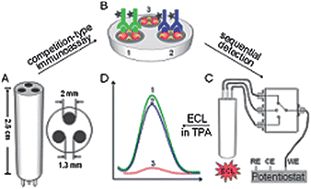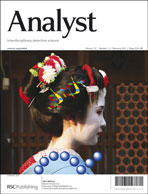Multianalyte immunoassay in a single run is often necessary to monitor or quantitate several components in a complex sample matrix for various purposes. In this paper we present a novel, individually addressable electrode array for sequential electrochemiluminescent (ECL) immunoassay using a non-array detector. An immunosensor array was fabricated by site-selectively immobilizing multiple antigens on different electrodes. With a competitive immunoassay format, the amounts of the bound Ru(bpy)32+ derivative labeled antibodies decreased with the increase of the antigens in the sample, and the ECL signals from different immunosensors were collected in turn by a photomultiplier with the aid of a home-made single-pore-three-throw switch. Using human IgG and rat IgG as model analytes, this multianalyte immunoassay showed detection limits down to 8.9 and 7.2 ng mL−1 for them, respectively. The results for real sample analysis demonstrated that this strategy can provide a simple, sensitive, low-cost and high-throughput ECL immunosensor array for clinical diagnosis.

You have access to this article
 Please wait while we load your content...
Something went wrong. Try again?
Please wait while we load your content...
Something went wrong. Try again?


 Please wait while we load your content...
Please wait while we load your content...